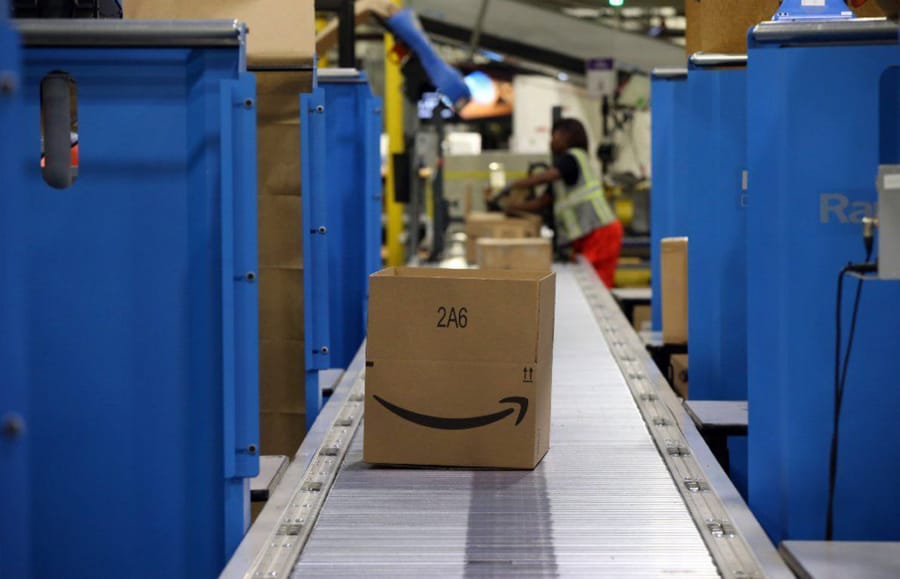Closed restaurants and shops, hoarding of household staples and a surge in online orders have exposed holes in America’s delivery network amid the coronavirus pandemic.
Now, while consumers search for products such as face masks, hand soap, toilet paper and groceries, companies are evaluating major changes to where their products are made and how those goods are delivered.
At a time when much of the commercial real estate industry is at a standstill, that spells dollars and jobs for developers, builders, shippers and others in the industrial real estate and logistics sectors. Long-term job gains may be minimized by increasing adoption of automation, though.
“This pandemic has moved everything up maybe five years, where people who weren’t ordering online have had no choice other than to use the internet,” said Tony Pricco, president of Chicago-based warehouse developer Bridge Development Partners. “Now they’re seeing how easy it is, and they’ll continue to use it.”
“There are definitely winners and losers that are going to come out of this,” he said.
With its huge population, central location and easy access to shipping by air, rail, waterways and interstates, Chicago long ago emerged as a key hub in an increasingly global supply chain. That makes the area well-positioned for upcoming changes, said Jason Tolliver, the Indianapolis-based leader of brokerage Cushman & Wakefield’s industrial business in the Americas.
“Chicago is the largest industrial market in the country,” Tolliver said. “It is the lynchpin for logistics, manufacturing and production.”
“Short-term and long-term, the story for Chicago is one of strength,” he said.
Even the most successful online retailers and busiest distribution hubs face challenges, as the COVID-19 health crisis has demonstrated.
Amazon’s vaunted distribution network has buckled under the strain of widespread stay-at-home mandates, creating huge backlogs of online orders of food and other items. Amazon is far from alone. Call up just about any retailer’s website and there’s a message about delayed shipments.
The struggles are a reminder that e-commerce, ubiquitous as it seems, is still emerging.
In 2019, 11% of all retail sales were from e-commerce, an increase from 9.9% the previous year, according to the Census Bureau.
“Most people would guess that the total percentage of online sales in this country is higher than it actually is,” said Mark Barbato, a director at Chicago-based office developer Sterling Bay, which is now branching out into industrial projects.
Every tick up in online sales requires vast swaths of additional real estate.
That has led to soaring demand in the Chicago area since the financial crisis more than a decade ago, likely leaving the industrial sector in a position to weather the latest downturn better than other property types such as office, retail and apartment buildings.
“What does that look like if it spikes to 15 or even 20%?” Barbato said of the share of online sales. “There’s certainly room to run.”
Once upon a time, retailers followed a hub-and-spoke distribution model, creating a massive warehouse — typically along an interstate — to supply dozens of stores in a region.
Online sellers upended that model by offering deliveries directly to consumers. As online sales rose and same-day delivery grew more popular, Amazon and its rivals assembled networks that now include smaller fulfillment centers near dense populations.
But despite all the building that’s gone on, the pandemic’s stay-at-home orders, panic buying and product shortages show there’s room for improvement.
Experts say companies may decide to bulk up their inventories. Meanwhile, retailers will continue gobbling up smaller urban facilities to get closer to homes.
That means added real estate costs, at a time when companies are hoarding cash and new buildings are more difficult to finance because of a faltering overall economy.
The costliest industrial buildings to construct, cold storage facilities, could be in particularly high demand after long backlogs of online grocery orders.
Broader adoption of grocery delivery will create demand for 75 million to 100 million square feet of new cold storage facilities nationwide, according to a report from commercial real estate brokerage CBRE.
Because of their high cost, freezer-cooler buildings are rarely built on speculation, or without tenants signed, he said. But with demand soaring, Bridge is considering spec projects in Los Angeles and Miami, Pricco said.
Factory space also could be in for a boost.
After experiencing shortages of some manufacturing components that come from hard-hit countries such as China, some U.S. companies are likely to return some production to the U.S., Tolliver said.
“The cost of the pandemic and the realization that these things can be paralyzing is really amplifying those conversations in boardrooms,” Tolliver said.
Manufacturers may choose to make parts in several locations throughout the country or world, to guard against illnesses or natural disasters in individual locations, he said.
The virus’ impact on large cities could be an additional consideration in site selection for warehouses, said Tinglong Dai, an associate professor in Johns Hopkins University’s Carey Business School.
“Factories in cities are very vulnerable,” Dai said. “That has long-term implications.”
Companies are making immediate changes to reduce the number of sick workers and quell fear, Dai said, such as Ford Motor Co. providing factory workers with Fitbit-like wristbands that emit loud sounds when people move within 6 feet of one another. Ford has shifted temporarily to making ventilators at some plants rather than automobiles.
Factories also are using technology to decrease touching of surfaces, such as automating doors and equipment, Dai said. Longer term, the health crisis will encourage broader adoption of artificial intelligence and other futuristic technologies in industrial buildings, he said.
“People always worry about automation eliminating jobs, but COVID-19 is killing millions of jobs,” Dai said. “This is the time for giant players like Amazon and Costco to double down on AI and the digital transformation.”



